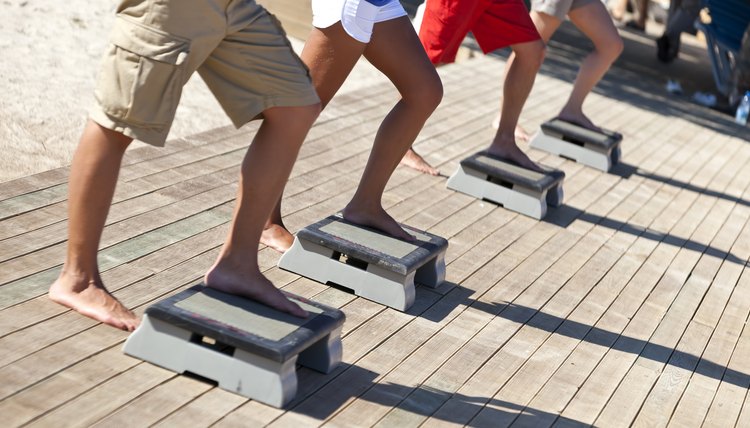What does fact checked mean?
At SportsRec, we strive to deliver objective content that is accurate and up-to-date. Our team periodically reviews articles in order to ensure content quality. The sources cited below consist of evidence from peer-reviewed journals, prominent medical organizations, academic associations, and government data.
The information contained on this site is for informational purposes only, and should not be used as a substitute for the advice of a professional health care provider. Please check with the appropriate physician regarding health questions and concerns. Although we strive to deliver accurate and up-to-date information, no guarantee to that effect is made.
Lunge Vs. Step-Up

If you’ve spent time in a gym or worked out with an exercise video, chances are good that you’re familiar with lunges and step-ups. Both exercises are effective for working nearly all the muscles in the legs. Both exercises actively recruit your quadriceps, gluteals and hamstrings that tone and define the legs.
The Lunge Plunge
With a basic lunge, you’re stepping forward – or backward – on one leg and lowering the knee to a 90-degree angle. This position also requires some balance. Both feet are always on the ground, so your weight is evenly distributed throughout the exercise. Keep your shoulders back and the spine neutral. The primary muscle that is working is the quadriceps, but a lunge is considered a compound exercise because it utilizes multiple muscles.
With a step-up, you’re stepping onto a higher surface whether it’s a step or a chair. Difficulty is determined by the height of the step or chair. For a brief period of time, your entire body weight is balanced on one leg while you’re stepping up. This exercise requires a fair amount of core strength because balance is required to maintain your form. While your body weight is balanced on one leg, your gluteals and abdominals are actively holding your body in the desired position. Step-ups increase agility and are also considered compound exercises.
The Combo Mambo
Both lunges and step-ups are extremely versatile and offer a wide variety of combinations. Changing the pace, stride or direction of your lunge or step-up can increase the difficulty of the exercise and may change some of the muscles being worked. Both exercises can be made more challenging by adding dumbbells or medicine balls. A quicker pace will elevate your heart rate while a slower pace will bring on the muscle burn. Both exercises can be combined to get the best of both worlds.
Considerations For Beginners
If you’re new to step-ups or lunges, it’s best to start slowly. Keep your range of motion fairly small until you are confident you can do more. Add weights or increase your stride when you’re ready. Add variation by doing them quickly – without compromising form – or slowly, to a count of four. Pay attention to your knees and stop immediately if you feel any sharp pain. Consult your physician before starting any exercise program.
References
Writer Bio
Kelly N. Vance is an ACE-certified personal trainer and accomplished fitness and nutrition writer who has worked in and written about the fitness industry for 10 years. Her additional qualifications include a Bachelor of Arts in psychology, a minor in English and multiple fitness certifications.
